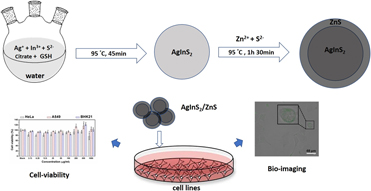Crossref Citations
This article has been cited by the following publications. This list is generated based on data provided by
Crossref.
Jose Varghese, R.
Parani, Sundararajan
Adeyemi, Olufemi O.
Remya, V. R.
Sakho, El Hadji Mamour
Maluleke, Rodney
Thomas, Sabu
and
Oluwafemi, Oluwatobi S.
2020.
Green Synthesis of Sodium Alginate Capped -CuInS2 Quantum Dots with Improved Fluorescence Properties.
Journal of Fluorescence,
Vol. 30,
Issue. 6,
p.
1331.
Jose Varghese, R.
Parani, Sundararajan
Remya, V.R.
Maluleke, Rodney
Thomas, Sabu
and
Oluwafemi, Oluwatobi S.
2020.
Sodium alginate passivated CuInS2/ZnS QDs encapsulated in the mesoporous channels of amine modified SBA 15 with excellent photostability and biocompatibility.
International Journal of Biological Macromolecules,
Vol. 161,
Issue. ,
p.
1470.
Borovaya, Mariya
Horiunova, Inna
Plokhovska, Svitlana
Pushkarova, Nadia
Blume, Yaroslav
and
Yemets, Alla
2021.
Synthesis, Properties and Bioimaging Applications of Silver-Based Quantum Dots.
International Journal of Molecular Sciences,
Vol. 22,
Issue. 22,
p.
12202.
Oluwafemi, Oluwatobi Samuel
Sakho, El Hadji Mamour
Parani, Sundararajan
and
Lebepe, Thabang Calvin
2021.
Ternary Quantum Dots.
p.
155.
Mbaz, Gracia It Mwad
Parani, Sundararajan
and
Oluwafemi, Oluwatobi Samuel
2022.
Controlled synthesis of silver-based ternary quantum dots with outstanding luminescence.
Journal of Fluorescence,
Vol. 32,
Issue. 5,
p.
1769.
Rajendran, Jose Varghese
Parani, Sundararajan
Pillay R. Remya, Vasudevan
Lebepe, Thabang C.
Maluleke, Rodney
Aladesuyi, Olanrewaju A.
Thomas, Sabu
and
Oluwafemi, Oluwatobi Samuel
2022.
Gelatin stabilized mesoporous silica CuInS2/ZnS nanocomposite as a potential near-infrared probe and their effect on cancer cell lines.
Journal of Materials Science,
Vol. 57,
Issue. 25,
p.
11911.
Canisares, Felipe S.M.
Mutti, Alessandra M.G.
Cavalcante, Dalita G.S.M.
Job, Aldo E.
Pires, Ana M.
and
Lima, Sergio A.M.
2022.
Luminescence and cytotoxic study of red emissive europium(III) complex as a cell dye.
Journal of Photochemistry and Photobiology A: Chemistry,
Vol. 422,
Issue. ,
p.
113552.
Ozdemir, Nur Koncuy
Cline, Joseph P.
Sakizadeh, John
Collins, Shannon M.
Brown, Angela C.
McIntosh, Steven
Kiely, Christopher J.
and
Snyder, Mark A.
2022.
Sequential, low-temperature aqueous synthesis of Ag–In–S/Zn quantum dots via staged cation exchange under biomineralization conditions.
Journal of Materials Chemistry B,
Vol. 10,
Issue. 24,
p.
4529.
Wang, Ji
Ma, Hao-Tian
Pan, Liang-Jun
Zhang, Li
and
Zhang, Zhi-Ling
2022.
Integrated synthesis and ripening of AgInS2 QDs in droplet microreactors: An update fluorescence regulating via suitable temperature combination.
Chinese Chemical Letters,
Vol. 33,
Issue. 8,
p.
3767.
Rajendran, Jose Varghese
Parani, Sundararajan
Pillay R Remya, Vasudevan
Lebepe, Thabang C.
Maluleke, Rodney
Thomas, Sabu
and
Oluwafemi, Oluwatobi Samuel
2022.
Selective and sensitive detection of Cu2+ ions in the midst of other metal ions using glutathione capped CuInS2/ZnS quantum dots.
Physica E: Low-dimensional Systems and Nanostructures,
Vol. 136,
Issue. ,
p.
115026.
Song, Jiahe
Zhang, Jingjing
Qi, Kezhen
Imparato, Claudio
and
Liu, Shu-yuan
2023.
Exploration of the g-C3N4 Heterostructure with Ag–In Sulfide Quantum Dots for Enhanced Photocatalytic Activity.
ACS Applied Electronic Materials,
Vol. 5,
Issue. 8,
p.
4134.
Cobongela, Sinazo Z. Z.
Makatini, Maya M.
May, Bambesiwe
Njengele-Tetyana, Zikhona
Bambo, Mokae F.
and
Sibuyi, Nicole R. S.
2024.
Antibacterial Activity and Cytotoxicity Screening of Acyldepsipeptide-1 Analogues Conjugated to Silver/Indium/Sulphide Quantum Dots.
Antibiotics,
Vol. 13,
Issue. 2,
p.
183.





